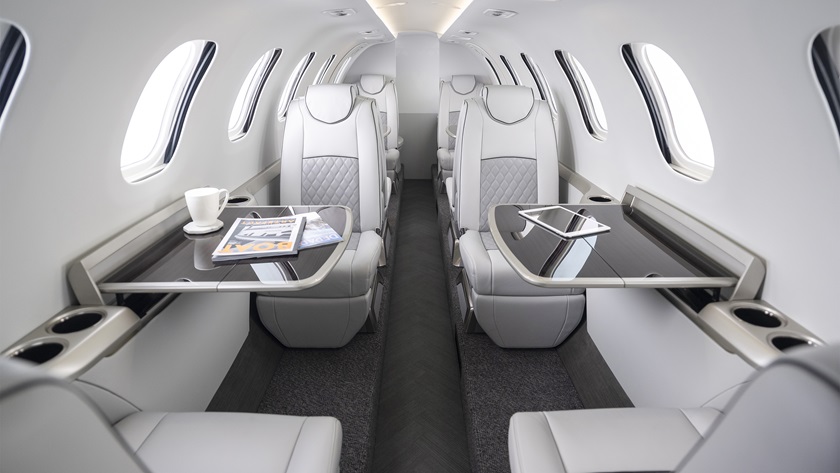Honda announces new larger jet concept
Model 2600 offers midsize comfort, range with light jet economics
Honda Aircraft officials hope to replicate with the new HondaJet 2600 the success the company found with the launch of its first product, the HondaJet HA–420.
As with the 420, the 2600 is being launched as a concept, in this case unveiled October 12 at the National Business Aviation Association Business Aviation Convention and Exhibition in Las Vegas.
Similarly, Honda Aircraft President and CEO Michimasa Fujino predicts his latest concept will deliver the performance and comfort of a midsize jet at the economics of a light jet.
With seating for up to 11 in a double club configuration, a high-speed cruise of 450 knots, maximum altitude of 47,000 feet, maximum takeoff weight of 17,500 pounds, and a transcontinental range of 2,625 nautical miles, the model 2600 has many of the characteristics of a midsize jet. However, Fujino predicts the airplane will consume 20 percent less fuel than similarly sized jets and will be 40 percent more fuel efficient than a midsize jet.
Stressing that the 2600 (spoken as “the two thousand six hundred”) is a concept, Fujino could not state what engines the new model might carry. However, it will retain the signature low-drag, over-the-wing-engine-mount system pioneered on the original model. Similarly, it will also fly on a natural laminar flow wing and have a natural laminar flow flight deck area. Inside, the flight deck will feature a Garmin G3000 panel. Fujino couldn’t provide any certification timeline, price point, or distribution method for the new model. He suggested that the model would be priced competitively with other light jets.
Official launch of the HA–420 15 years ago seemed to depend heavily upon the reaction to its announcement, which ultimately influenced the corporation’s decision to move forward with developing its first airplane.
Fujino has told me numerous times over the years that the 420 was designed to be a part of a family of airplanes. When asked about a new model in 2016, he replied with a smile and a polite nod, “I like family.”
 In a conversation prior to the public announcement, he stressed that the 2600 is meant to give operators that need to fly between distant city pairs, such as New York and Los Angeles or London and Cairo, the opportunity to do so at an efficiency level currently not available and to do so without compromising on comfort. He emphasized that the 2600’s large cabin space, low noise level, low vibration level, and cabin altitude of just 6,362 feet at Flight Level 470 promise a comfortable ride for passengers. The low fuel burn demonstrates Honda’s commitment to sustainability and decreased carbon emissions—an important point for any new business jet.
In a conversation prior to the public announcement, he stressed that the 2600 is meant to give operators that need to fly between distant city pairs, such as New York and Los Angeles or London and Cairo, the opportunity to do so at an efficiency level currently not available and to do so without compromising on comfort. He emphasized that the 2600’s large cabin space, low noise level, low vibration level, and cabin altitude of just 6,362 feet at Flight Level 470 promise a comfortable ride for passengers. The low fuel burn demonstrates Honda’s commitment to sustainability and decreased carbon emissions—an important point for any new business jet.
The cabin will feature a modular design, allowing for three configurations to accommodate between nine and 11 occupants—a double club for 11 occupants, an executive configuration for nine, and a divan configuration for 10. A bed configuration is available in each of the three. And, according to Honda literature, the cabin will feature the highest cabin ceiling in its class and seven feet between facing seats.
Fujino stressed that the concept is far more than the mockup unveiled at NBAA. The project has already undergone much engineering and will share many components with the HA–420, meaning that once a decision is made to move forward, the project can progress quickly, given the company’s experience in certifying the original HA–420 and several upgrades to the current model, the HondaJet Elite S.
With a range some 1,200 nm farther than the Elite S, the 2600 provides the creature comforts one would expect when going further, including a significantly larger external baggage compartment—nearly double that of a typical light jet, according to a company press release.
Up front, the Garmin G3000 panel includes the latest features, such as autothrottles and a runway overrun awareness and alerting system, which uses real-time data to predict stopping distance and alerts if a safe landing is not achievable. In addition, the 2600 will include autobraking via its brake-by-wire system, giving the pilot the opportunity to set braking aggressiveness in advance. An advanced steering augmentation system helps detect changes in aircraft yaw rate and provides directional assistance to nosewheel steering for increased stability and tracking, reducing workload and increasing safety.
Fujino said customer feedback and a changing business aviation industry caused him to develop the new model.
“Over the past five years, we introduced the HondaJet Elite, then the Elite S, to further enhance the original HondaJet design,” he said. “Now, we are validating market demand as we unveil an entirely new aircraft concept in a different segment from the original HondaJet. With the HondaJet 2600 concept, which enables efficient transcontinental flight, offers [a] new level of cabin comfort and capacity, and dramatically reduces CO2 emissions, we are introducing a new generation of business jets.”





